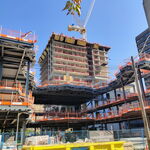Leo_Chan
Senior Member
I've noticed a common construction staging method for a lot of highway interchanges and overpasses build a new overpass off to the side of the existing arterial road, reroute the road to use the new bridge, then demolish the old road. Is the main reason to save construction costs from building a temporary road off to the side to replace the existing alignment? Do terrain and environmental conditions also a factor when choosing alignment?
I know it doesn't impact much in the grand scheme of things, but it causes the road grid at the highways to curve a little bit and looks "unnatural" when you're viewing satellite maps and see the unaligned roads.
I know it doesn't impact much in the grand scheme of things, but it causes the road grid at the highways to curve a little bit and looks "unnatural" when you're viewing satellite maps and see the unaligned roads.




